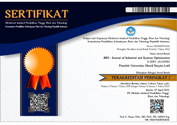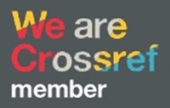ALTERNATIF PERANCANGAN TATA LETAK MESIN PRODUKSI DI CV. ANUGERAH SUKSES SEJAHTERA
DOI:
https://doi.org/10.51804/jiso.v2i2.49-54Keywords:
Algoritma Corelap, Mesin bubut, Momen Perpindahan, Tata Letak MesinAbstract
Tata letak mesin adalah suatu hal yang penting jika dikaitkan dengan kegiatan proses produksi di perusahaan, karena dapat meminimalkan ruang produksi yang di butuhkan. Pada penelitian ini akan menggunakan metode Algoritma Corelap, adapun sumber data yang digunakan adalah data-data primer dan sekunder dari press release. Data akan dianalisa dengan pengumpulan seluruh nilai Total Closeness Rating stasiun kerja pada lantai produksi dan melakukan perhitungan corelap dengan cara mencari nilai tertinggi. Berdasarkan analisa data yang dilakukan, diperoleh kesimpulan bahwa pada penggunaan metode Algoritma Corelap dapat meminimalkan frekuensi pemindahan barang dan mempermudah jalannya proses produksi.
References
Dwianto, Q. A., Susanty, S., & Fitria, L. (2016). Usulan Rancangan Tata Letak Fasilitas Dengan Menggunakan Metode Computerized Relationship Layout Planning (CORELAP) di Perusahaan Konveksi. REKA INTEGRA, 4(1).
Muther, R. (1973). Systematic Layout Planning/by Richard Muther.
Oktiarso, T., & Loekito, H. S. (2017). PERANCANGAN ULANG TATA LETAK AREA PRODUKSI PT X DENGAN METODE SYSTEMATIC PLANT LAYOUT. Prosiding SENIATI, 3(2), 51–53.
Putra, Y. P. (2018). MERANCANG TATA LETAK FASILITAS PABRIK DENGAN METODE ALGORITMA CORELAP DI CV. ROBBANI SINGOSARI. Jurnal Valtech, 1(1), 65–70.
RAJAMANI*, D., Singh, N., & Aneja, Y. P. (1996). Design of cellular manufacturing systems. International Journal of Production Research, 34(7), 1917–1928.
Setiawan, B. S. A. D. (2017). HUBUNGAN KELELAHAN TERHADAP KINERJA SUPIR DUMP TRUCK PT RAYA BUMI MANDIRI SAMARINDA.
Wignjosoebroto, S. (2009). Tata letak pabrik dan pemindahan bahan. Surabaya: Guna Widya.
Yuliant, R., Saleh, A., & Bakar, A. (2014). Usulan Perancangan Tata Letak Fasilitas Perusahaan Garmen CV. X dengan menggunakan Metode Konvensional. REKA INTEGRA, 2(3).
Downloads
Published
Issue
Section
License
With the receipt of the article by JISO Editorial Board and the decision to be published, the copyright regarding the article will be transferred to JISO. The copyright transfer form can be downloaded here.
JISO has the right to multiply and distribute the article and every author is not allowed to publish the same article that was published in this journal.
JISO is licensed under a Creative Commons Attribution-ShareAlike 4.0 International License.
Under the following terms:
Attribution — You must give appropriate credit, provide a link to the license, and indicate if changes were made. You may do so in any reasonable manner, but not in any way that suggests the licensor endorses you or your use.
ShareAlike — If you remix, transform, or build upon the material, you must distribute your contributions under the same license as the original.














